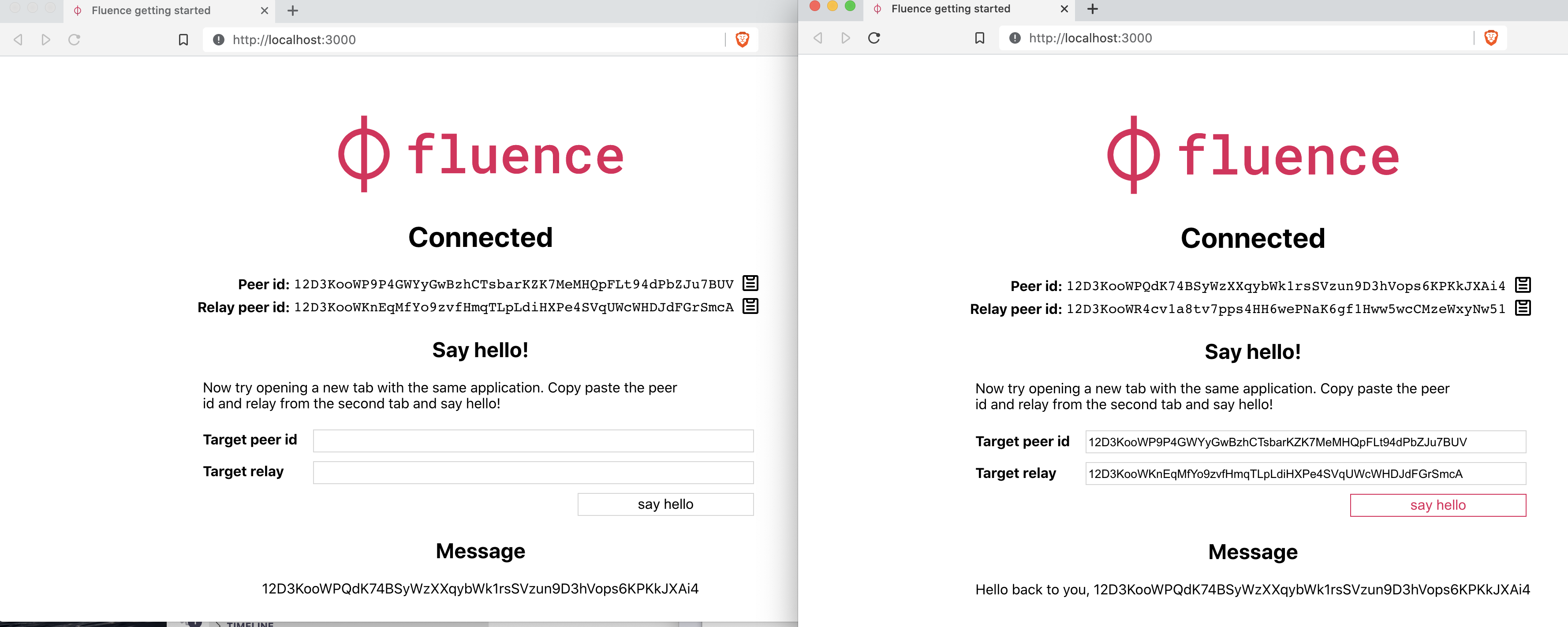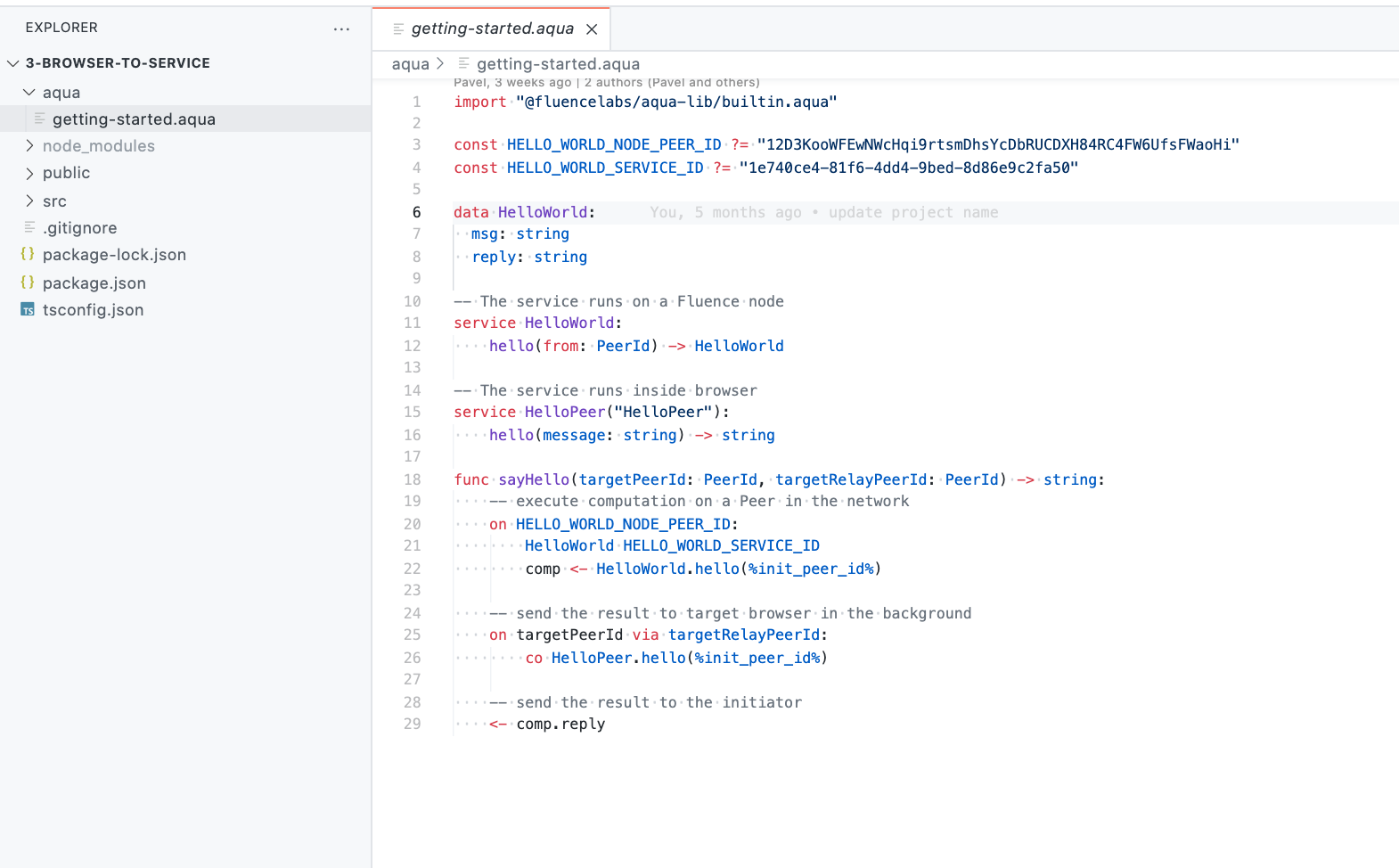3.9 KiB
3. Browser-to-Service
In the first section, we explored browser-to-browser messaging using local, i.e. browser-native, services and the Fluence network for message transport. In the second section, we developed a HelloWorld Wasm module and deployed it as a hosted service on the testnet peer 12D3KooWFEwNWcHqi9rtsmDhsYcDbRUCDXH84RC4FW6UfsFWaoHi with service id 1e740ce4-81f6-4dd4-9bed-8d86e9c2fa50 . We can now extend our browser-to-browser messaging application with our hosted service.
Let's navigate to the 3-browser-to-service directory in the VSCode terminal and install the dependencies:
npm install
And run the application with:
npm run compile-aqua
npm start
Which will open a new browser tab at http://localhost:3000 . Following the instructions, we connect to any one of the displayed relay ids, open another browser tab also at http://localhost:3000, select a relay and copy and paste the client peer id and relay id into corresponding fields in the first tab and press the say hello button.
The result looks familiar, so what's different? Let's have a look at the Aqua file. Navigate to the aqua/getting_started.aqua file in your IDE or terminal:
And let's work it from the top:
- Import the Aqua standard library (1)
- Provide the hosted service peer id (3) and service id (4)
- Specify the
HelloWorldstruct interface binding (6-8) for the hosted service from themarine aquaexport - Specify the
HelloWorldinterface and function binding (11-12) for the hosted service from themarine aquaexport - Specify the
HelloPeerinterface and function binding (15-16) for the local service - Create the Aqua workflow function
sayHello(18-29)
Before we dive into the sayHello function, let's look at why we still need a local service even though we deployed a hosted service. The reason for that lies in the need for the browser client to be able to consume the message sent from the other browser through the relay peer. With that out of the way, let's dig in:
- The function signature (18) takes two arguments:
targetPeerId, which is the client peer id of the other browser and thetargetelayPeerId, which is the relay id -- both parameters are the values you copy and pasted from the second browser tab into the first browser tab - The first step is to call on the hosted service
HelloWorldon the host peerhelloWorldPeerId, which we specified in line 1- We bind the
HelloWorldinterface, on the peerhelloWorldPeerId, i.e.,12D3KooWFEwNWcHqi9rtsmDhsYcDbRUCDXH84RC4FW6UfsFWaoHi, to the service id of the hosted servicehelloWorldServiceId, i.e.1e740ce4-81f6-4dd4-9bed-8d86e9c2fa50, which takes the %init__peer__id% parameter, i.e., the peer id of the peer that initiated the request, and pushes the result intocomp(20-22) - We now want to send a result back to the target browser (peer) (25-26) using the local service via the
targetRelayPeerIdin the background as acoroutine. - Finally, we send the
compresult to the initiating browser
- We bind the
A little more involved than our first example but we are again getting a lot done with very little code. Of course, there could be more than one hosted service in play and we could implement, for example, hosted spell checking, text formatting and so much more without much extra effort to express additional workflow logic in our Aqua script.
This brings us to the end of this quick start tutorial. We hope you are as excited as we are to put Aqua and the Fluence stack to work. To continue your Fluence journey, have a look at the remainder of this book, take a deep dive into Aqua with the Aqua book or dig into Marine and Aqua examples in the repo.

